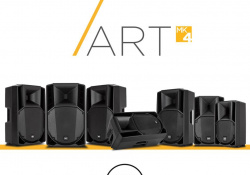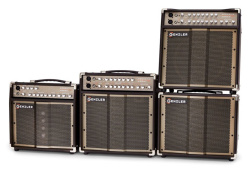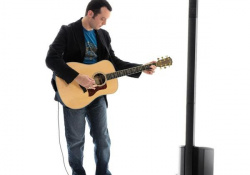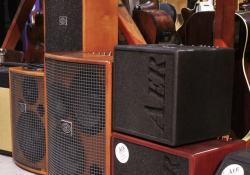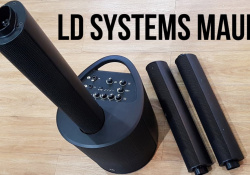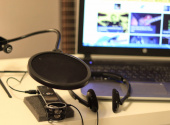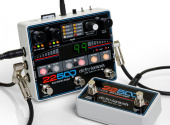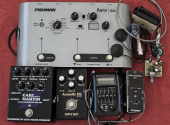
The Handbook for Electro Acoustic Guitarists, Chapter 9: Amplification
We've gradually worked our way up to the "last link in the food chain" – the amplifier. So what is the best way to amplify the sound of an acoustic guitar? Again, the solution is sort of Solomonic, because it always depends on your specific situation, needs and requirements. There is no perfect solution for all occasions, but fortunately, there are plenty of options and I'll highlight three main approaches.
Acoustic combo
This is, of course, the first solution any acoustic player will think of. There are all the important components together in one neat box, plus it's usually relatively small, lightweight and stylish looking. Everything is included: guitar and mic inputs, EQ, custom amp, speaker and DI output, which is great. Plus, today's range across the price and quality spectrum is fantastic and everyone can choose what they like. The long-standing benchmark in this segment is the AER brand used by professionals and amateurs alike, but you won't go wrong with Acus, Fender, Fishman, Hughes & Kettner or the new, upmarket Boss Acoustic Singer. Acoustic combos are also often offered by bass gear manufacturers, as the principle of desired amplification is the same and they usually differ only in the EQ frequency area and higher power output. The latter again depends on the situation. A 30-watt output may be fine for a quiet grouping, but with a drummer, even 100 watts may not be enough. This is because acoustic amps are in most cases solid-state, so they are not as loud as tube combos for electric guitars.
But how about using a tube combo? It's certainly possible, but personally, I'd leave that to only those who know well what sound they expect because their advantages cannot compensate for the several times higher price, weight and overall more difficult handling. But as it goes in real life, the shoemaker's children go barefoot (or rather used to): at the beginning of my acoustic career, for a long time, I played an East German tube combo that always took up the whole front trunk of my Skoda 120. My only excuse is that in the dim old days, there was practically no choice. Plus, "electric" speakers play mostly mids, whereas acoustic guitar requires wide-band speakers, so it must have been a big sonic compromise.
It is a good idea to avoid cheap little combos, which are more of a starter for beginners and don't fulfill the required requirements (in delivering at least some bass). I used to be even stricter saying that small things don't play. But rapid development and constant innovation have forced me to change this rhetoric to "small (and cheap) things don't play", because companies like MARKBASS are showing wonders and their “small things” can play great (well, not for cheap anymore). After all, my most used combo nowadays is from exactly the same category – tiny, lightweight and a bit expensive.
Also, I don't recommend a combo to be played at your place, it is counterproductive for acoustics and inconsiderate of the neighbours. After all, when I need to hear myself electrified (effects or looper), I preferably use a more powerful Bluetooth speaker (only you have to try and choose them, as they often have unacceptable signal delay for live playing). It is advisable to set the sound on the combo as loud as possible on the input (without distortion of the signal) and control the overall volume (output). Equalization and effects have already been covered in the previous parts, so I would recommend an acoustic combo to those who don't want to get into it much, don't have their own equipment (effects), or as a check monitor on stage (that everything works for you and the sound engineer has to look elsewhere for any errors).
Active speakers
But if you're an acoustic player with multiple effects that you want to easily control and adjust, and you would like to have the sound set up well before the final amplification, then such a special combo is unnecessary for you. You just need to be amplified (so that you can hear yourself well) with what are called active speakers/monitors. Moreover, they have one of the best price/performance/quality/weight/size ratios for our purposes. With a sufficient power reserve, they can play bass well and, which may be missing in smaller combos, very often they are shaped diagonally so that they can also work as a stage receiver or monitor. All of this is especially advantageous for noisy applications, larger stages, or, on the contrary, for smaller venues as a replacement for a PA system. Incidentally, thanks to the rapid development and high quality of speaker simulators (mainly thanks to Impulse Response technology), electric guitarists have started to use these speakers in droves. Again, I would recommend avoiding the cheapest ones and looking more at the level of Italian RCF – today probably the most respected brand among professionals.
However, there's no need to go overboard with size or power ratings in the hundreds of watts, eight to ten-inch speakers will suffice and you won't be pushing them to extreme peaks anyway due to the constant threat of feedback. I use an active monitor where the aforementioned mini combo is no longer enough (classically with drums, for example). It's also nice to still have your sound on stage, which you're used to and can regulate yourself without depending on others. You know how it works – everyone wants to hear themselves more than the others. Of course, the market for "actives" is broad and everyone can choose according to their particular preferences and wallet. And as we have slowly moved into the realm of sound technology, I will mention one more interesting option.
Compact portable line array system
Under this long name lies a modern hybrid between a monitor and a PA system, with which BOSE has broken into the market. It not only replaces personal monitors but can also sound smaller to medium-sized venues, and is therefore popular with musicians who are used to relying on themselves and don't want to depend on a sound engineer or local PA, either technically or cost-wise. They are compact, lightweight, transportable, easy to plug in, save on cabling and fill the space sonically more naturally than conventional speakers.
Because of these undeniable advantages, many other companies have started to produce similar speakers with wide horizontal coverage together with a subwoofer base, so again, anyone can choose according to their personalised tastes and requirements. The choice is yours because it is impossible to balance in one way such conflicting demands for space, musical style, volume, power, storage, simplicity, weight and extension functions as today's diverse music making demands. But the great thing is that we live in a ready-made music gear paradise and all our needs in various quality and price categories can be met.
If you have found an error or typo in the article, please let us know by e-mail info@insounder.org.

